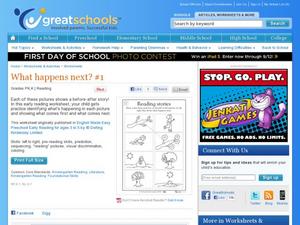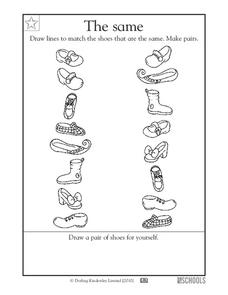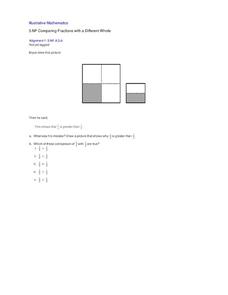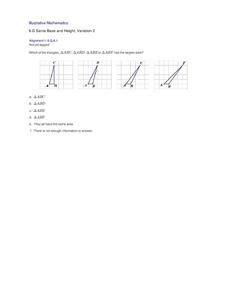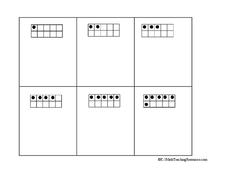Curated OER
What Happens Next? 1
Knowing how to sequence events means you have to know what happens before and after. Little ones draw a line from four before images to the images that show what happened next. This is a good challenge for your youngest learners.
Curated OER
Odd One Out
Which of these wacky shapes is different? Learners examine five rows of figures, each with a starting shape at the beginning. They determine which of the four following shapes looks different from the first, circling it. Consider having...
Curated OER
Congruent Shapes
Which of these shapes is congruent? Young geometers examine five familiar shapes: triangle, oval, rectangle, triangle, and circle. Each is followed by a set of shapes, of which one is congruent. They circle the congruent...
Curated OER
The Same
Which shoes match? This is surely an activity your preschoolers do daily, so use it in an educational way. They match shoes to make pairs, connecting the matches with a line. There are eight pairs in all. Next, youngsters get to draw a...
Curated OER
Real-Life Problems
There's a party going on! Learners examine an image of a birthday party and answer 10 analysis questions. They employ a variety of math skills including telling time, days of the week, division, subtraction, multiplication, addition,...
Curated OER
Same Shape and Size
Can your kindergartners recognize shapes? What about when they are in different orientations? Youngsters study groups of shapes to determine which have the same shape and size. Two of the groups have triangles and ovals, and the other...
Curated OER
Which One's Different?
One of these things is not like the others! Preschoolers identify which sock and glove is different from the rest, and draw a ring around the outlier. Then, they draw a sock and glove that are different from given pictures. Color the...
Curated OER
Drugs and Safety Precautions
Drugs can both help and harm depending on how they are used. Fifth graders complete a worksheet that provides background information on prescription drugs. They read the text and then describe why medication manufacturers label pill...
Curated OER
Fly Detective
Learners use classification skills and clues to determine which flying insect is the one they need to circle. They read four clues and examine each of the five insects depicted. They then deduce which one is the mystery insect. Answers...
Champions for Change
How Many Cups Do I Need?
Does an apple a day really keep the doctor away? Find out by browsing through a variety of handouts and learning the recommended daily amounts of fruits and vegetables for good health. Learners will read and discuss how to visually...
Curated OER
Comparing Fractions with a Different Whole
What was Bryce's mistake? Through analysis of a student work example, learners develop their own ability to compare the fractions one fourth and one half. Central to this activity is the concept that, when comparing fractions, the whole...
Illustrative Mathematics
Same Base and Height, Variation 2
This is a good model for learners to visualize triangles of the same base and height. They can can begin to comprehend that these triangles will have the same area no matter how the triangle is drawn. It is part of a series of resources...
Illustrative Mathematics
Video Game Credits
Help your learners understand how to divide fractions with this visual activity. They first answer a simple inequality before dividing the fractions. Two solution choices are given to help your mathematicians understand how to solve "how...
John Talavera
Autism iHelp – Language Concepts
A parent of a child with autism, and a speech-language pathologist together developed this language-intervention app to be used with students with severe to moderate autism.
Perkins School for the Blind
Conservation of Mass
How do you teach a student with visual impairments about the conservation of mass? You use tactile models that represent the theoretical concept. Baking soda and vinegar are used to add gas to a deflated balloon. Learners will feel the...
Curated OER
Using the Imperfect Tense & the Preterite Tense
In Spanish, there are several verb tenses used to express things that happened in the past. The tricky part is figuring out which one is appropriate for your situation. Let this resource help you and your pupils as they master the...
South Gloucestershire Council
Animal Classification: A Collaborative Sorting Activity for Key Stages 2 & 3
Introduce the logic behind a dichotomous key or administer a group performance assessment with a fun and challenging classification lesson. With explicit instructions for the teacher and for collaborative groups, as well as engaging...
Homeschool Math
Equivalent Fractions Worksheet
Fraction circles are the primary feature of this worksheet for practicing calculating equivalent fractions. It includes 10 practice problems and an answer key, and supports visual interpretation of this...
Kids' Pages
Feelings Matching 1
Even subtle differences in facial expressions can give us a glimpse into how others are feeling. Through this visual matching activity, youngsters work to correctly connect 16 feelings to their appropriate facial expressions.
K-5 Math Teaching Resources
Ten Frame Cards
Support your visual learners on their journey to mathematical understanding with this collection of ten frame cards. Representing numbers from 1 to 42, these pictures can be used in any number of ways to introduce children to the concept...
K-5 Math Teaching Resources
Unlabelled Fraction Strips Template
Support your young mathematicians' introduction to the world of fractions with this simple printable resource. Offering students a hands-on opportunity for learning how to visually represent fractions, this template would make...
Positively Autism
"Other People Can Be First" Social Skills Story
Remind learners that sometimes other people might like to be first to answer questions, drink from the water fountain, get to the classroom, and other common daily events. This resource includes nine story slides of visuals and simple...
It's About Time
Who Eats Whom?
Packed with visual aids and multiple learning opportunities, an engaging exercise challenges individuals as they explore the role of producers, consumers, and decomposers. After discussing differences between food chains, food...
Scholastic
Study Jams! Area of a Parallelogram
Get introduced to the idea of square units and how to calculate the area of a parallelogram. The resource provides a visual lesson to measuring different types of this shape and how it relates to square units.
Other popular searches
- Visual Arts
- Visually Impaired
- Visual Art Self Portrait
- Visual Art Lesson Plans
- Teacher Resources Visual Art
- Visual Art Lessons
- Visual and Performing Arts
- Visual Art Lessons Symmetry
- Visual Discrimination
- Visual=art
- Visual Art Tessellations
- Visually Impaired Blind


